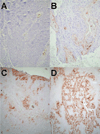The level of secretory leukocyte protease inhibitor is decreased in metastatic head and neck squamous cell carcinoma
- PMID: 21503571
- PMCID: PMC4164221
- DOI: 10.3892/ijo.2011.1006
The level of secretory leukocyte protease inhibitor is decreased in metastatic head and neck squamous cell carcinoma
Abstract
Head and neck squamous cell carcinomas (HNSCC) represent the sixth largest group among all human malignancies. However, the exact molecular mechanisms inducing the genesis and the progression of metastasis in these tumors are poorly understood. The identification of molecular alterations involved in metastasis of HNSCC might influence the value of clinical diagnostics, impact therapy strategies and finally improve the prognosis of the patients. The purpose of this study was to identify clinically relevant alterations at the transcriptional and translational levels, when comparing metastatic (N+) and non-metastatic (N0) primary HNSCC. Three transcripts HERPUD1, SLPI and RAD51 were selected for further validation based on their association with carcinogenesis and metastasis. Quantitative real-time-PCR was performed to determine the mRNA expression levels. For subsequent confirmation of the results, immunohistochemistry was performed applying a monoclonal anti-SLPI antibody on 121 HNSCC tumor specimens (N0, n=40; N+, n=81). In metastatic primary cancer, SLPI mRNA showed 5.9-fold lower expression in comparison with non-metastatic primary cancer (p=0.0092). Immunohistochemical staining revealed a fold change of -1.79 between the N+ and the N0 group (p=0.0002). The results presented here clearly indicate the repression of SLPI, measurable on both, mRNA and protein levels in metastatic primary HNSCC as compared to non-metastatic HNSCC. Therefore, it can be assumed that SLPI might have a substantial protective effect on the metastasis process of HNSCC.
Figures



Similar articles
-
Human papillomavirus infection in head and neck cancer: the role of the secretory leukocyte protease inhibitor.Oncol Rep. 2013 May;29(5):1962-8. doi: 10.3892/or.2013.2327. Epub 2013 Mar 5. Oncol Rep. 2013. PMID: 23467841 Free PMC article.
-
The role of the antileukoprotease SLPI in smoking-induced human papillomavirus-independent head and neck squamous cell carcinomas.Int J Cancer. 2014 Mar 15;134(6):1323-34. doi: 10.1002/ijc.28462. Epub 2013 Sep 23. Int J Cancer. 2014. PMID: 23996702
-
The antileukoprotease secretory leukocyte protease inhibitor (SLPI) and its role in the prevention of HPV-infections in head and neck squamous cell carcinoma.Cancer Lett. 2015 Feb 1;357(1):339-345. doi: 10.1016/j.canlet.2014.11.043. Epub 2014 Nov 24. Cancer Lett. 2015. PMID: 25462861
-
Salivary secretory leukocyte protease inhibitor (SLPI) and head and neck cancer: The Cancer Prevention Study II Nutrition Cohort.Oral Oncol. 2016 Apr;55:1-5. doi: 10.1016/j.oraloncology.2016.02.004. Epub 2016 Feb 24. Oral Oncol. 2016. PMID: 27016010 Free PMC article.
-
Secretory leukocyte protease inhibitor (SLPI) in cancer pathophysiology: Mechanisms of action and clinical implications.Pathol Res Pract. 2023 Aug;248:154633. doi: 10.1016/j.prp.2023.154633. Epub 2023 Jun 21. Pathol Res Pract. 2023. PMID: 37356220 Review.
Cited by
-
The synergistic effect of chemical carcinogens enhances Epstein-Barr virus reactivation and tumor progression of nasopharyngeal carcinoma cells.PLoS One. 2012;7(9):e44810. doi: 10.1371/journal.pone.0044810. Epub 2012 Sep 14. PLoS One. 2012. PMID: 23024765 Free PMC article.
-
Smoking-Induced SLPI Expression Hinders HPV Infections Also in Squamous Cell Carcinomas of the Vulva.Transl Oncol. 2019 Jan;12(1):36-42. doi: 10.1016/j.tranon.2018.09.004. Epub 2018 Sep 26. Transl Oncol. 2019. PMID: 30267960 Free PMC article.
-
Tonsillar swabs and sputum predict SLPI- and AnxA2 expression in tonsils: A prospective study on smoking dependent SLPI- and AnxA2-expression, and tonsillar HPV infection.Oncol Lett. 2022 May;23(5):164. doi: 10.3892/ol.2022.13284. Epub 2022 Mar 28. Oncol Lett. 2022. PMID: 35414827 Free PMC article.
-
Secretory leukocyte protease inhibitor (SLPI) as a potential target for inhibiting metastasis of triple-negative breast cancers.Oncotarget. 2017 Nov 26;8(65):108292-108302. doi: 10.18632/oncotarget.22660. eCollection 2017 Dec 12. Oncotarget. 2017. PMID: 29312532 Free PMC article.
-
Syndemic synergy of HPV and other sexually transmitted pathogens in the development of high-grade anal squamous intraepithelial lesions.Papillomavirus Res. 2017 Dec;4:90-98. doi: 10.1016/j.pvr.2017.10.004. Epub 2017 Nov 7. Papillomavirus Res. 2017. PMID: 29179876 Free PMC article.
References
-
- Parkin DM, Bray F, Ferlay J, Pisani P. Global cancer statistics, 2002. CA Cancer J Clin. 2005;55:74–108. - PubMed
-
- Akervall J. Gene profiling in squamous cell carcinoma of the head and neck. Cancer Metastasis Rev. 2005;24:87–94. - PubMed
-
- Chin D, Boyle GM, Porceddu S, Theile DR, Parsons PG, Coman WB. Head and neck cancer: past, present and future. Expert Rev Anticancer Ther. 2006;6:1111–1118. - PubMed
-
- Pantel K, Brakenhoff RH. Dissecting the metastatic cascade. Nat Rev Cancer. 2004;4:448–456. - PubMed
-
- Robbins KT, Clayman G, Levine PA, et al. Neck dissection classification update: revisions proposed by the American Head and Neck Society and the American Academy of Otolaryngology-Head and Neck Surgery. Arch Otolaryngol Head Neck Surg. 2002;128:751–758. - PubMed
Publication types
MeSH terms
Substances
Grants and funding
LinkOut - more resources
Full Text Sources
Other Literature Sources
Medical
Research Materials

